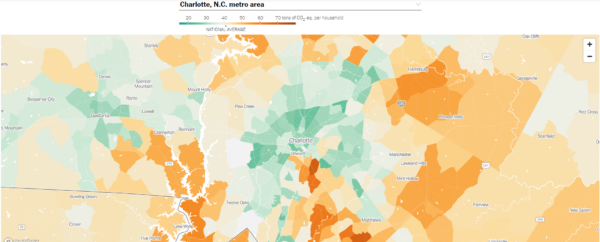What does your household contribute to climate change?

Bird’s eye view of a neighborhood. Credit: Canva
What does your household contribute to climate change? The New York Times took a look at consumption-based emissions at the local level nationwide and offered a comprehensive look at the role neighborhood density and personal wealth play.
Consumption-based emissions, the calculation of all of the greenhouse gas emissions associated with producing, transporting, using, and disposing of products and services consumed by a particular community, indicates that the densest and most transit-friendly neighborhoods near the city center have the lowest emissions per household nationwide thanks to residents’ ability to walk, bike or use public transit to get to stores and jobs. This proves true in Charlotte, too. Smaller homes also use less energy to heat and cool.
In more distant suburbs, average emissions per household can be two to three times as high because homes tend to get bigger and residents tend to drive longer distances.
Similarly, higher-income households tend to buy more stuff and travel more, both of which produce more greenhouse gases.
“When individuals or households want to know what influence they have over emissions, a consumption-based carbon footprint is the most relevant indicator,” said Chris Jones, director of the CoolClimate Network at the University of California, Berkeley, which developed the methodology behind the data set, said in this New York Times article. “And it can help us see what sorts of larger systemic changes are necessary” to help cities reduce those emissions, he said.
What does this mean for Charlotte?
Here’s a peek at the Charlotte metro’s average household emissions. (View the interactive map.)

Demographic Map of Charlotte. Credit: The New York Times
Photo: The New York Times
Charlotte is a perfect example of suburban sprawl. As this map indicates, lower-income neighborhoods west, north, and east of uptown (the “crescent”) have lower emissions than the national average and the city’s wealthier southern “wedge.” Suburban areas and surrounding towns have higher emissions as well.
What can we do about it?
Climate change is a global problem, but there are steps individuals can take to help.
Transportation
Cars and trucks are the largest sources of climate pollution in Charlotte (40%). You can help by walking, biking, riding transit, and carpooling as much as possible.
Communication
We listen to the people we know best. Talk about sustainability, like the ways you’re reducing your carbon footprint, with your friends, family, and co-workers.
Amplification
The city and county have robust plans to expand our transit, bicycle, pedestrian, and greenway networks, but they require funding to implement. Tell your elected officials that you want more safe, convenient, and climate-friendly transportation options.
Abundant housing
Apartments, townhomes, and duplexes require less land per person than single-family homes, help reduce car-dependent urban sprawl, and make our neighborhoods more diverse and walkable. Support the construction of these types of homes.
Relocation
Living closer to where you work reduces your impact on the climate because it reduces your need for long commutes. While this can be challenging, explore the idea of living in closer proximity to your workplace or to convenient public transit that can get you there.
Community solutions
“For both climate change and affordability reasons, we need to be building smaller homes in denser places, closer together and closer to jobs, to public transportation,” said Jenny Schuetz, a housing researcher at the Brookings Institution in the New York Times article.
Solutions for local government could include things like sourcing more electricity from renewable sources, retrofitting existing homes to be more energy efficient, reducing food waste, and increasing recycling. Local governments can make the single largest impact on climate issues by creating infill housing, like apartments and townhomes.
Locating stores, restaurants, and other necessities within a short distance from suburban homes can also reduce automobile travel. Community center hubs can also support better access to transit or commuter rail.
The Charlotte Future 2040 Comprehensive Plan recommends a number of policies that will help our city grow in a more equitable and climate-friendly way. The City of Charlotte’s Corridors of Opportunity initiative aims to create neighborhood centers that are walkable, bikeable, and transit-friendly. Wherever you live, you can help ensure that your neighborhood grows sustainably. Check out the Community Area Planning opportunities.
It’s important that city leaders honor and implement these policies and plans.
We also need to move faster on determining a new dedicated funding source for transportation infrastructure to build a transit system and safer streets for walking and biking that will allow residents to drive less.
Sustain Charlotte monitors and advocates for local plans and policies such as these and will continue to share opportunities for you to use your voice.
Here are several ways you can get involved to reduce your neighborhood’s carbon footprint today.
Thanks for reading!
As a nonprofit, community support is essential for us to keep doing what we do — including providing free articles like this. If you found this article helpful, please consider supporting Sustain Charlotte.
Want to stay in the loop? Subscribe to our weekly newsletter and follow us on Instagram, Facebook, and Twitter.
